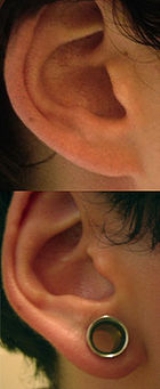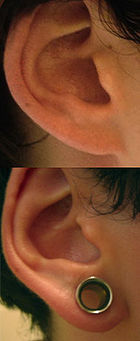
Scalpelling
Encyclopedia

Body art
Body art is art made on, with, or consisting of, the human body. The most common forms of body art are tattoos and body piercings, but other types include scarification, branding, scalpelling, shaping , full body tattoo and body painting.More extreme body art can involve things such as mutilation...
procedure similar to body piercing
Body piercing
Body piercing, a form of body modification, is the practice of puncturing or cutting a part of the human body, creating an opening in which jewelry may be worn. The word piercing can refer to the act or practice of body piercing, or to an opening in the body created by this act or practice...
for the creation of decorative perforations through the skin and other body tissue, and is most commonly used as a replacement for or enhancement of ear piercing. Whereas piercing is typically performed with a hollow piercing needle or an ear piercing instrument, scalpelling is performed by using a scalpel
Scalpel
A scalpel, or lancet, is a small and extremely sharp bladed instrument used for surgery, anatomical dissection, and various arts and crafts . Scalpels may be single-use disposable or re-usable. Re-usable scalpels can have attached, resharpenable blades or, more commonly, non-attached, replaceable...
to cut a slit into the skin. Unlike dermal punching, no flesh is removed. The technique can immediately produce holes with a larger diameter than can be achieved by piercing. This is a more rapid means of accommodating larger gauge
American wire gauge
American wire gauge , also known as the Brown & Sharpe wire gauge, is a standardized wire gauge system used since 1857 predominantly in the United States and Canada for the diameters of round, solid, nonferrous, electrically conducting wire...
jewellery than stretching
Stretching (body piercing)
Stretching, in the context of body piercing, is the deliberate expansion of a healed fistula for the purpose of wearing body piercing jewelry. Ear piercings are the most commonly stretched piercings, with nasal septum piercings, tongue piercings and lip piercings/lip plates following close behind...
, a technique whereby piercings are enlarged by inserting gradually larger jewellery. Scalpelling is performed to quickly achieve a large-gauge piercing, when scar tissue
Scar
Scars are areas of fibrous tissue that replace normal skin after injury. A scar results from the biological process of wound repair in the skin and other tissues of the body. Thus, scarring is a natural part of the healing process. With the exception of very minor lesions, every wound results in...
is preventing further stretching, if tissue has thinned to the point where further stretching could cause it to break, or to combine two closely placed piercings into one hole.
Though the wounds associated with scalpelling are large, the extremely sharp nature of the scalpel leads to a wound which is more likely to heal cleanly and without complications. Further, the use of scalpelling rather than stretching allows for greater control over which parts of the flesh will be used and can act to correct piercings that are unbalanced or poorly located.
Scalpelling is a fairly new body modification technique, and is still quite rare. It is most commonly performed on earlobes, but can also be used for such modifications as labret
Labret
A labret is one form of body piercing. Taken literally, it is any type of adornment that is attached to the facial lip . However, the term usually refers to a piercing that is below the bottom lip, above the chin...
s.
Scalpelling should not be confused with a form of scarification
Scarification
Scarifying involves scratching, etching, burning, or superficially cutting designs, pictures, or words into the skin as a permanent body modification.In the process of body scarification, scars are formed by cutting or branding the skin...
, whereby images are inscribed in a person's skin using a scalpel.
Risks
Because of the skill required by scalpelling and the danger associated with additional blood loss, scalpelling by piercers is not legal in some jurisdictions.One potentially negative effect of scalpelling is that the holes created by the process are less likely to close naturally over time than those from stretched piercings. Though it is still possible in some cases, especially at smaller sizes, it is far more likely that an unwanted hole would have to be closed surgically.

